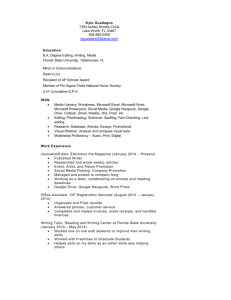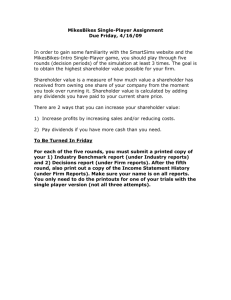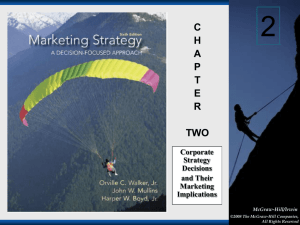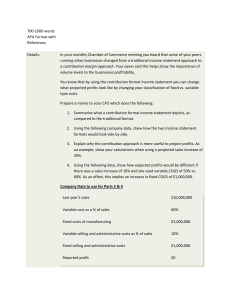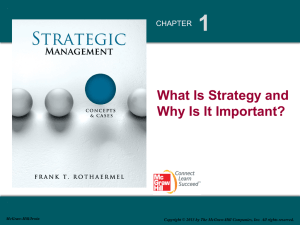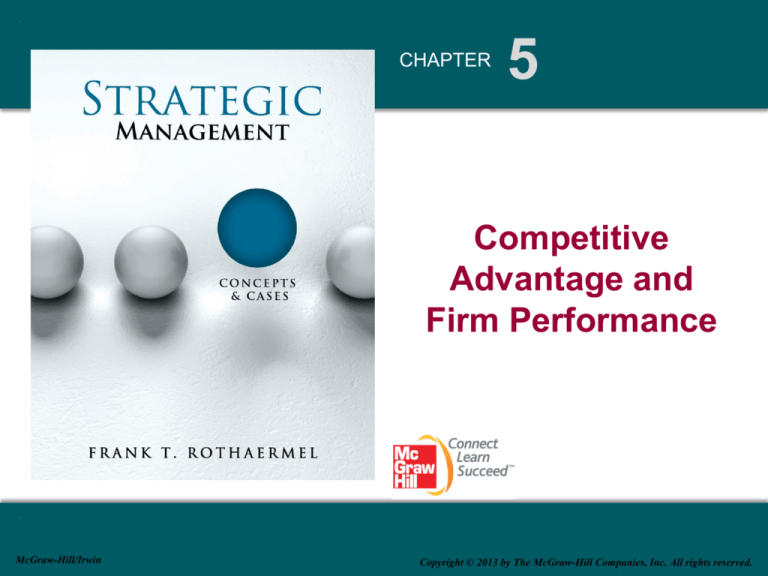
CHAPTER
5
Competitive
Advantage and
Firm Performance
McGraw-Hill/Irwin
Copyright © 2013 by The McGraw-Hill Companies, Inc. All rights reserved.
Part 1 Strategy Analysis
5–2
LO 5-1 Describe and evaluate economic value creation when
measuring competitive advantage.
LO 5-2 Describe and evaluate accounting profitability when
measuring competitive advantage.
LO 5-3 Describe and evaluate shareholder value creation when
measuring competitive advantage.
LO 5-4 Describe and evaluate the balanced-scorecard approach
for assessing competitive advantage.
LO 5-5 Describe and evaluate the triple-bottom-line approach
when assessing competitive advantage.
LO 5-6 Compare and contrast different approaches to measuring
competitive advantage, and derive managerial implications.
5–3
How Do We Measure Performance?
• “The strategic aim of a business is to
earn a return on capital, and if in any
particular case the return in the long
run is not satisfactory, then the
deficiency should be corrected or
the activity abandoned for a more
favorable one.”
Alfred P. Sloan
My Years with General Motors
5–4
Chapter Case 5
Google vs. Microsoft
• Google and Microsoft in multipoint competition
How to measure success of this competition?
Revenues and net income?
Performance per employee?
•
There are several ways to measure firm performance.
•
The key idea is to “triangulate” (i.e., to use multiple
measures of performance to evaluate the health of
the organization).
5–5
EXHIBIT 5.1
Comparing Google & Microsoft on Different Dimensions
Performance viewpoint changes significantly when the
measurement changes from absolute to per-employee
figures (on the bottom)
5–6
7
8
2-20
Tradeoff Between Profitability
and Growth Rate
PMAX
Profitability
P1
P2
G0
G1
G2
Growth Rate
Copyright 1998 by Houghton Mifflin Company. All rights reserved.
Economic Profits and Competitive Advantage
• Driving a wedge between revenues and costs is how
competitive advantage is created.
• In strategy, we need to think simultaneously about:
The value we create for our customer;
How we capture some of the value in terms of higher prices;
The costs we incur in creating that value.
• Conceptual traps that managers fall into:
Accounting costs versus Opportunity Costs
Market Share is not competitive advantage
Measuring Competitive Advantage
• Always measured relative to other firms
• Three standards are typical by asking:
1. How much economic value does the firm generate?
2. What is the firm’s accounting profitability?
3. How much shareholder value does the firm create?
5–11
Economic Value Creation
• Value: A dollar amount a
consumer is willing to pay
for a good or service
• Price: The dollar amount a
good or service is offered
for sale
• Pizza!
• Value = $12
• Price = $10
• Cost = $7 SOLD!
• Consumer Surplus
$12 - $10 = $2
• Cost: The dollar amount to
make the good or service
• Producer Surplus
$10 - $7 = $3
• Economic Value
$12 - $7 = $5
5–12
EXHIBIT 5.2
Competitive Advantage & Economic Value
COMPETITIVE
ADVANTAGE =
HIGHEST
VALUE
–
COST
5–13
Economic Value Creation
• Opportunity Costs
The next best alternative use for resources
Pizza entrepreneur
Wages
Capital invested
$40,000 employment salary
$25,000 interest on capital
If the restaurant made $60,000 in (accounting) profits…
The owner actually had an economic LOSS of $5,000
Economic Value as Competitive Advantage
• If the economic value created is
greater than its rivals competitive advantage
equal to its rivals competitive parity
lower than its rivals competitive disadvantage
Sustainable Competitive Advantage and
the Measurement of Performance
• While we have said that the objective of strategy is to
“create competitive advantage,” specifically we have
the goal to maximize economic return.
• Economic & Accounting
Measures of Performance
Economic Profits
ROA, ROE, ROC
Discounting Cash Flows
Horizon
CFt
CF3
CF1
CF2
Valuet+1
…
+
+
+
=
+
+
NPV
1+r
(1+r)2 (1+r)3
(1+r)t
(1+r)t+1
NPV: Net Present Value
CFt: Cash Flow at time t
• Financial Measures
Performance
NPV Methods
r:
Discount rate
Horizon Value: Value of
ongoing enterprise after time t
of
16
Financial Measures of Performance: NPV or DCF Analysis
• The principle of discounted cash flow (DCF) analysis that
firms apply to their individual projects can also be applied
to the firm as a whole. Maximizing the net present value
of the firm’s cash flow (“sustainable competitive advantage”)
corresponds to maximization of its stock market valuation
and hence maximizes the wealth of its shareholders.
Cash Flow +
0
Time
5–17
Net Cash Flow
• EBT - t (EBT)
• EBT (1-t) = NET INCOME
• EBT (1-t) + depreciation - capital expenditures =
NET CASH FLOW
(note we are assuming no change in accounts receivable, no
change in net working capital, no change in inventory)
• Equivalent concepts:
Maximize NPV
DCF Approach
Maximize Economic Profits (EVA)
Sustainable Competitive Advantage (SCA)
Limitations of Present Value Measures
• Projections are only as good as the ability of managers to
measure accurately the financial consequences of actions.
• An implicit assumption of value-based strategy was that
business units and all investment proposals were selfcontained. It was usually expected that divesting a business
or curtailing an investment project would have no financial
repercussions elsewhere in the corporation (e.g., ignores
knowledge transfers).
• Strict financial measurement of many long-term
investments, particularly in intangible assets,
is virtually impossible.
19
Limitations of Present Value Measures
• Investments in R&D typically do not offer direct returns; their
economic value is a strategic option to invest in new products
and processes that may arise from R&D. Narrowly- defined
DCF does not accurately value investments where there is
significant strategic options value.
(Merck has been at the forefront of applying
strategic options theory to analyze
investments in R&D).
Capital Market Approaches To Measuring Performance
• Market Value Added (MVA)
Market Value less Total Investment
• Economic Value Added (EVA)
Operating Profit (after tax) less annual capital costs; basically,
this is economic profit
• Tobin’s q (Market Value/Book Value)
A firm’s market value divided by its “replacement” cost
• The Market Value of the Firm Current Value of all securities issued by the firm
21
Economic Value Added (EVA)
• Anheuser-Busch: Operating profit $1,756
million - taxes $617 million = $1,139 million
• WACC : 67% equity at 14.3%
33% debt at 5.2%
11.3% WACC
Capital of $8 billion
11.3% * $8billion = $904 million
$1,139 - $904 = $235 million EVA
22
Firms with the Highest Ratios of Market Value to Book Value
(December 2005)
Company
Valuation
ratio
Country
Company
Valuation
ratio
Country
Yahoo! Japan
72.0
Japan
Coca-Cola
7.8
US
Colgate-Palmolive
20.8
US
Diageo
7.4
UK
Glaxo Smith Kline
13.4
UK
3M
7.3
US
Anheuser-Busch
12.6
US
Nokia
6.7
Finland
eBay
11.2
US
Sanofi-Aventis
6.3
France
SAP
10.8
Germany
AstraZeneca
5.9
UK
Yahoo!
10.7
US
Johnson & Johnson
5.7
US
Dell Computer
10.0
US
Boeing
5.7
US
Sumitomo Mitsui Financial
8.8
Japan
Eli Lily
5.6
US
Procter & Gamble
8.4
US
Cisco Systems
5.5
US
Qualcomm
8.3
US
Roche Holding
5.5
Switz.
Schlumberger
8.2
US
L’Oreal
5.3
France
Unilever
8.1
Neth/UK
Altria
5.2
US
PepsiCo
8.0
US
Novartis
5.1
Switz.
LO 5-1 Describe and evaluate economic value creation when measuring
competitive advantage.
LO 5-2 Describe and evaluate accounting profitability when
measuring competitive advantage.
LO 5-3 Describe and evaluate shareholder value creation when measuring
competitive advantage.
LO 5-4 Describe and evaluate the balanced-scorecard approach for
assessing competitive advantage.
LO 5-5 Describe and evaluate the triple-bottom-line approach when
assessing competitive advantage.
LO 5-6 Compare and contrast different approaches to measuring
competitive advantage, and derive managerial implications.
5–24
Accounting Profitability
• Uses standard, publicly available metrics
• Permits direct firm performance comparisons
Using standard ratios
• Regulated by:
Accounting principles (GAAP)
U.S. Securities & Exchange Commission (SEC)
Sarbanes-Oxley Act (2002)
1–25
EXHIBIT 5.3
Top 10 Fortune 500 Companies by Profits ($M)
5–26
EXHIBIT 5.4
Top 10 Fortune 500 Companies by Return on Revenue
ROR measures the profit earned per dollar of revenue as a percentage.
A size-adjusted measure of profits.
5–27
Profits vs. Return on Revenue (ROR)
Ranking changes markedly with
the use of different metrics
2010 Profits in $M
2010 ROR %
5–28
Accounting Profitability
• Need to move beyond a “snapshot” metric
Look at more than one year of data
• Permits direct firm performance comparisons
Using standard ratios
• Competitive advantage is relative to competitors
Study firms in the same industry
“Apples to apples” comparisons
5–29
EXHIBIT 5.5
Firm Performance - Pharmaceutical Industry by ROR
Pfizer performance declines as Merck improves and
takes the competitive advantage over this period
5–30
Drawbacks for Accounting Measures
• Does not consider “off balance sheet” items
Health care, pension obligations
• Focuses on tangible assets, which may no longer
be strategically relevant
Key is intangible assets
“Knowledge-based economy”
Manufacturing vs. Services
• Historical data
Backward-looking
“Driving a car by looking in the review mirror”
5–31
EXHIBIT 5.6
Declining Importance of Book Value in Stock Valuation
5–32
LO 5-1 Describe and evaluate economic value creation when measuring
competitive advantage.
LO 5-2 Describe and evaluate accounting profitability when measuring
competitive advantage.
LO 5-3 Describe and evaluate shareholder value creation when
measuring competitive advantage.
LO 5-4 Describe and evaluate the balanced-scorecard approach for
assessing competitive advantage.
LO 5-5 Describe and evaluate the triple-bottom-line approach when
assessing competitive advantage.
LO 5-6 Compare and contrast different approaches to measuring
competitive advantage, and derive managerial implications.
5–33
Shareholder Value Creation
• Shareholders – legal owners of public firms
Total return to shareholders
Return on risk capital + dividends
External performance metric
Efficient-market hypothesis
All available information is embedded in the stock price
• SEC requires all public firms to submit
shareholder returns
• Stock price based on expectations of performance
5–34
EXHIBIT 5.7
Normalized Stock Returns 2005–2010
5–35
Drawbacks to Shareholder Value as Competitive Advantage
• Stock prices can be highly volatile, which makes it
difficult to assess firm performance (at least in the
short term)
• Macro economic factors (e.g., unemployment rate,
economic growth or contraction, interest rate and
exchange rates…) all have a direct bearing on stock
prices
• Stock prices frequently reflect the psychological mood
of the investors, which can be at times irrational
“Irrational exuberance” Alan Greenspan, former Federal Reserve Chair
Dan Ariely Video
Google vs. Microsoft
• Accounting perspective shows Microsoft with an
advantage over Google.
But both firms have large intangible assets.
• BUT shareholder value favors Google over
Microsoft!
Microsoft stock is flat while Google is up 200%.
5–37
EXHIBIT 5.8
Comparing Google and Microsoft Using ROE and ROA
Microsoft outperforms Google in 2010 based on this accounting data
5–38
EXHIBIT 5.9
Normalized Stock Returns 2005–2010
Google is enjoying a
sustained
competitive
advantage over
Microsoft based on
shareholder value.
5–39
LO 5-1 Describe and evaluate economic value creation when measuring
competitive advantage.
LO 5-2 Describe and evaluate accounting profitability when measuring
competitive advantage.
LO 5-3 Describe and evaluate shareholder value creation when measuring
competitive advantage.
LO 5-4 Describe and evaluate the balanced-scorecard approach for
assessing competitive advantage.
LO 5-5 Describe and evaluate the triple-bottom-line approach when
assessing competitive advantage.
LO 5-6 Compare and contrast different approaches to measuring
competitive advantage, and derive managerial implications.
5–40
41
THE BALANCED SCORECARD
• Advantages
Communicate vision
thru the organization
• Disadvantages
Tool for strategy
implementation not
formulation.
Translate vision into
measureable goals
Limited guidance on
selecting metrics
Design business
processes
Implement
organizational
learning
Limited insight on
how to get back on
track to meet goals
Can be viewed as just
a tracking tool for
metrics
5-42
EXHIBIT 5.10
A Balanced-Scorecard Approach to Competitive Advantage
5-43
Balanced Scorecard Example
STRATEGIC DIRECTION
Strategies &
Objectives
PERFORMANCE MEASUREMENT
Current-Year
Initiatives
Business Results
Financial
• Annual revenue - $X
• Profit before tax - $X
• ROA - X%
• Revenue per employee - $X
Overriding Purpose:
Process
Assessments
Leadership
• Make improvement in work
environment as measured by
employee survey
• Gain recognition for
community relations
Customer/Consumer
• Improve customer delivery
• Increase sales to Europe
• Meet customer loyalty goals
• Reduce defects
Strategies & Objectives
Partner/Supplier/Operations
• Develop strategy and plan to have
suppliers own material inventory
• Supplier contribution to cost reduction
• Achieve inventory turns goal
Human Resources
• Balance the Human Resource availability
with initiative requirements, establish plans,
& execute
• Implement diversity plan
• Plan and execute strategic staffing plan
SBU-Specific
• Develop rapid prototyping processes and
match prototype capacity to business needs
• Software process improvement to goal
• Acquire new services customers to meet
plans
• Meet on-time product launch goal
Group
Strategic Planning
• Establish an effective strategybased M&A process.
Customer & Mkt Focus
• Complete market segment
analysis
• Tie sales plan & budgets to group
regional goals
Information/Analysis
• Provide IT support for
decentralized operations
Human Resources
• Develop a comprehensive college
recruiting strategy
• Implement an employee feedback
process
Process Mgmt
• Complete ISO 9000 tasks as
planned
• Improve overall new product
introduction process
SBU
5-44
The Triple Bottom Line
• Financial, Social, and
Ecological Considerations
EXHIBIT 5.11
Also known as "People,
Planet, & Profits"
BP oil spill had many
major effects
BMW changed car
designs to enhance
recycling
Integrative approach for
sustainable strategy
The Triple Bottom Line
STRATEGY HIGHLIGHT 5.1
Interface: The World’s First
Fully Sustainable Company
• Interface is a global leader in modular carpet tiles
Business to business so not a consumer name
In 1994, founder & CEO set a BHAG
Highly industrial, petroleum-intensive business to go “off oil”!
By 2008, estimates savings at $400 million
Energy efficiency
Recycled raw materials instead of virgin material
Sustainability as a market differentiator
Employee motivation
1–46
LO 5-1 Describe and evaluate economic value creation when measuring
competitive advantage.
LO 5-2 Describe and evaluate accounting profitability when measuring
competitive advantage.
LO 5-3 Describe and evaluate shareholder value creation when measuring
competitive advantage.
LO 5-4 Describe and evaluate the balanced-scorecard approach for
assessing competitive advantage.
LO 5-5 Describe and evaluate the triple-bottom-line approach when
assessing competitive advantage.
LO 5-6 Compare and contrast different approaches to measuring
competitive advantage, and derive managerial implications.
5-47
EXHIBIT 5.12
How Do We Measure Competitive Advantage?
5-48
Implications for the Strategist
• Both quantitative AND qualitative performance
dimensions matter.
Managers need to have a holistic view
• Competitive advantage is best by criteria,
reflecting overall company performance
Metrics aggregate upward, useful to gauge firm's
strategy
• Only better strategy is our goal.
No best strategy exists
Strategic performance metrics must be relative
5–49
50



